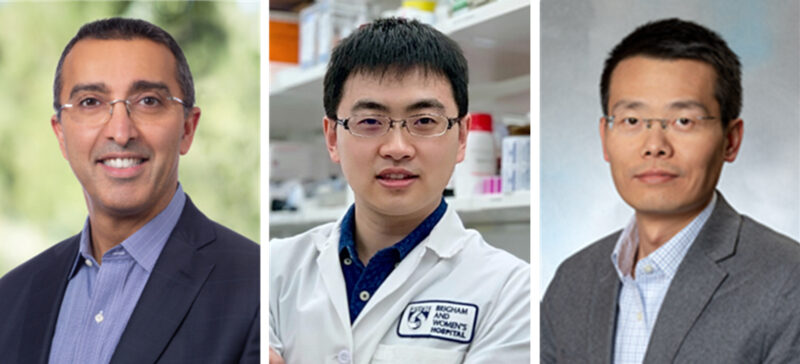
Director, Center for Nanomedicine
Physician-Scientist, Department of Anesthesiology, Perioperative and Pain Medicine, Brigham and Women’s Hospital
Professor, Harvard Medical School
Faculty member, Center for Nanomedicine and Department of Anesthesiology, Perioperative and Pain Medicine, Brigham and Women’s Hospital
Assistant Professor, Harvard Medical School
Faculty member, Center for Nanomedicine and Department of Anesthesiology, Perioperative and Pain Medicine, Brigham and Women’s Hospital
Associate Professor, Harvard Medical School
Mitchel B. Harris, MD
Co-director, Stepping Strong Center, Brigham and Women’s Hospital
Chief, Department of Orthopaedics, Massachusetts General Hospital
Using Multifunctional Scaffolds to Promote Bacterial-Free Bone Healing and Regeneration
Injuries from accidents and severe trauma can cause large open bone fractures and, in more extreme cases, large bone defects. Such injuries are frequently prone to poor bone healing and high rates of infection. As a result, orthopedic trauma surgeons are often challenged to both stabilize and repair bone injuries, while also promoting an optimal environment to prevent infection and aid bone healing. Currently, the standard of care is crude. A cement paste containing antibiotics to kill infecting bacteria is molded into the open fracture and the wound is closed up. This procedure has several problems. At best only ~25% of the antibiotic is released from the cement, and since the cement is not biodegradable patients require further operations to remove it. The cement can also cause bacterial biofilms to grow on its surface leading to more infection. In addition to wound infection, another obstacle of bone tissue healing is that mesenchymal stem cells cannot be effectively convened. Therefore, in this project, we are harnessing the powers of nanotechnology and tissue engineering approaches to treat infections and lack of healing in bone fractures. In this case, our multifunctional scaffold with the capacity of recruiting stem cells, controlled antibacterial via photothermal therapy and pro-osteogenesis are highly expected to meet the demand.
Omid Farokhzad, MD, MBA, established and directs the Center for Nanomedicine at Brigham and Women’s Hospital. He is a faculty member of the Brigham Research Institute Cancer Research Center and the Dana Farber/Harvard Cancer Center. Farokhzad and his team of scientists have developed a myriad of nanotechnologies for medical applications. He has authored more than 180 papers and is an inventor of more than 180 issued or pending patents worldwide. The technologies that Farokhzad and colleagues have developed formed the basis for the launch of five biotechnology companies: BIND Therapeutics, Selecta Biosciences, Tarveda Therapeutics, Placon Therapeutics, and Seer Biosciences. Farokhzad’s research is focused on the development of medical nanoparticle technologies; most notably, he pioneered the high throughput combinatorial development and screening of multifunctional nanoparticles for medical applications: from therapeutics delivery to early detection.
Wei Tao, PhD, is a biomedical investigator with a multidisciplinary background in materials science, nanotechnology, biomedical engineering, and biology. His career commitment is to develop strategies for unmet medical needs in health care to improve patients’ lives. The key focus of his study has been to develop biomaterials for efficient delivery of various therapeutics, and to understand their nano-bio interactions. His research thrusts include fundamental materials innovation as well as their various applications in translational medicine, which will lead to novel solutions that can finally impact patients’ lives in the future. He has established exceptional expertise in the design and synthesis of functional biomaterials, the revelation of nano-bio interactions for mechanism studies, and the exploration of different biomedical applications including RNA therapeutics, cancer theranostics, wound healing, cardiovascular disease, bone regeneration, diabetes treatment, etc.
Jinjun Shi, PhD, holds an academic appointment of Associate Professor at Harvard Medical School, and is a faculty member in the Center for Nanomedicine at Brigham and Women’s Hospital. He has extensive experience in the research fields of nanomedicine and drug delivery, and has developed many multifunctional nanoparticle platforms for the delivery of small molecules, proteins, peptides and nucleic acids (e.g., siRNA). Research in Jinjun’s team involves a highly interdisciplinary combination of nanotechnology, biomaterials, drug delivery, and immunotherapy. In particular, his team interested in i) RNAi technology for gene silencing; ii) mRNA delivery for restoration of tumor suppressors; iii) nanoparticle-mediated immune modulation; and iv) development of stimuli-responsive nanomaterials and bioinspired antioxidative polymers.
RELATED ARTICLES:
An Interview with Stepping Strong Breakthrough Awardee Wei Tao, PhD
